Mapping the Recent Vertical Crustal Deformation of the Weihe Basin (China) Using Sentinel-1 and ALOS-2 ScanSAR Imagery
Abstract
:1. Introduction
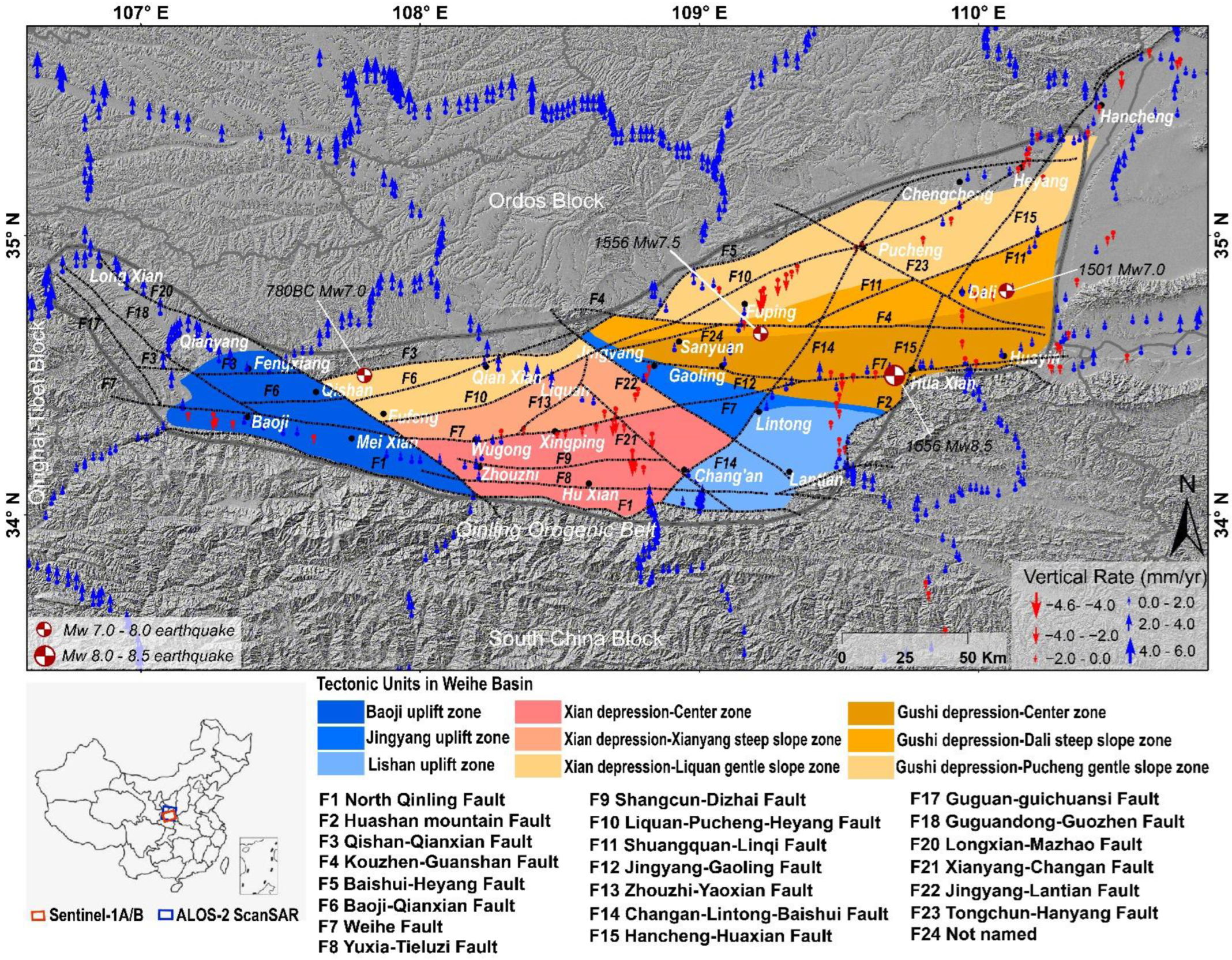
2. Datasets and Processing Methods
2.1. Multitemporal InSAR (MTI) Processing
2.1.1. PS-InSAR Processing
2.1.2. SBAS Processing
2.1.3. MTI Processing
2.2. Stacking Method
2.3. Multidimensional Small-Baseline Subset Method
2.4. SAR Data and Processing
2.5. Leveling Data
3. Results
3.1. Long-Term Deformation Rate of the Weihe Basin
3.2. Two-Dimensional Deformation Maps
3.3. Accuracy Assessment
4. Analysis of Active Faults
5. Construction of a Fault Model and Inversion of the Slip Distribution
5.1. Fault Geometry Configuration and Modeling Method
5.2. Simulation Results and Analysis
6. Discussion about InSAR-identified Active Fault Traces
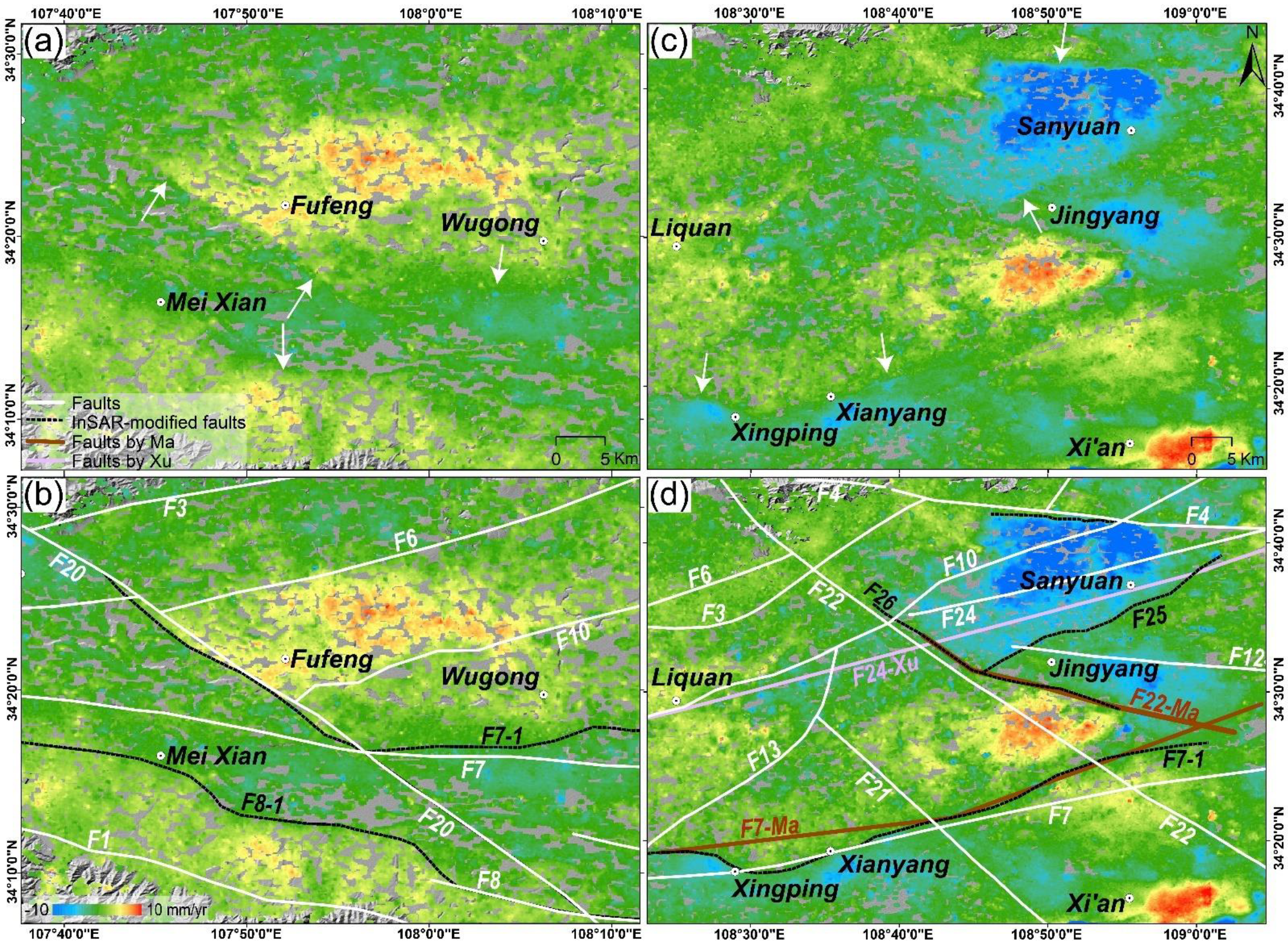
7. Conclusions
Supplementary Materials
Author Contributions
Funding
Acknowledgments
Conflicts of Interest
References
- Zhang, Y.Q.; Mercier, J.L.; Vergély, P. Extension in the graben systems around the ordos (China), and its contribution to the extrusion tectonics of south china with respect to gobi-mongolia. Tectonophysics 1998, 285, 41–75. [Google Scholar] [CrossRef]
- Chen, Q.; Xiong, R.; Tian, Q. Segmentary characteristics of the geometrical structure of the longxian-qishan-mazhao active fault. Earthquake 2019, 38, 66–80. [Google Scholar]
- Peng, J. Tectonic evolution and seismicity of weihe fault zone. Seismol. Egology 1992, 14, 113. [Google Scholar]
- Peng, J.; Su, S.; Zhang, J. The Active Faults and Geohazards in Weihe Basin; Northwest University Press: Xi’an, China, 1992. [Google Scholar]
- Qu, W.; Lu, Z.; Zhang, Q.; Wang, Q.; Hao, M.; Zhu, W.; Qu, F. Crustal deformation and strain fields of the weihe basin and surrounding area of central china based on gps observations and kinematic models. J. Geodyn. 2018, 120, 1–10. [Google Scholar] [CrossRef]
- Rao, G.; Lin, A.; Yan, B.; Jia, D.; Wu, X. Tectonic activity and structural features of active intracontinental normal faults in the weihe graben, central China. Tectonophysics 2014, 636, 270–285. [Google Scholar] [CrossRef] [Green Version]
- Hu, Y.H.; Song, M.; Jia, S.; Zhi, Z.P. Present crustal motion inthree-dimensional orientations and fault activities in weihe basin. J. Geodesy Geodyn. 2018, 38, 1220–1226. [Google Scholar]
- Lin, A.; Rao, G.; Yan, B. Flexural fold structures and active faults in the northern–western weihe graben, central China. J. Asian Earth Sci. 2015, 114, 226–241. [Google Scholar] [CrossRef] [Green Version]
- Deng, Q.; Zhang, P.; Ran, Y.; Yang, X.; Min, W.; Chu, Q. Basic characteristics of active tectonics of China. Sci. China Ser. D-Earth Sci. 2003, 46, 356–372. [Google Scholar] [CrossRef]
- Cui, D.X.; Hao, M.; Li, Y.H.; Wang, W.P.; Qin, S.L.; Li, Z.J. Present-day crustal movement and strain of the surrounding area of ordos block derived from repeated gps observations. Chin. J. Geophys. 2016, 59, 3646–3661. [Google Scholar]
- Cui, D.; Hao, M.; Qin, S.; Wang, W. Inversion of fault dip-slip rate and locking depth in central-southern shaanxi of China. Chin. J. Geophys. 2019, 62, 4648–4657. [Google Scholar]
- Zhang, Q.; Qu, W.; Peng, J.; Wang, Q.; Li, Z. Research on tectonic causes of numerous ground fissures development mechanism and its unbalance distribution between eastern and western of weihe basin. Chin. J. Geophys. 2012, 55, 2589–2597. [Google Scholar]
- Hu, B.; Zhu, Y.; Tian, Q.; Cheng, H. Studyongravityfieldand itsdynamicevolutionalcharacteristicsintheguanzhongarea. Earthq. Res. China 2006, 22, 172. [Google Scholar]
- Chen, J.; Zhou, Y.; Chen, G.; Hao, M. Decades of ground deformation in the weihe graben, shaanxi province, china, in response to various land processes, observed by radar interferometry and levelling. Remote Sens. 2021, 13, 2374. [Google Scholar] [CrossRef]
- Bureau, S.P.S. Active Fault Celt in North Margin of the Qinling Mountains; Seismological Press: Beijing, China, 1996. [Google Scholar]
- Yang, P.; Ren, Z.; Zhang, J.; Xia, B.; Tian, T.; Cai, Z.; Zhang, Y. Discussion of the coupling relationships between the cenozoic sedimentary-tectonic migration of the weihe basin and the uplift of the weibei and east qinling areas. Chin. J. Geol. 2018, 53, 876–892. [Google Scholar]
- Rao, S.; Jiang, G.Z.; Gao, Y.J.; Hu, S.B.; Wang, J.Y. The thermal structure of the lithosphere and heat source mechanism of geothermal field in weihe basin. Chin. J. Geophys. 2016, 59, 2176–2190. [Google Scholar]
- He, H. Study on the Formation Mechanism of Ground Fissures in Weihe Basin. Ph.D. Thesis, Chang’an University, Xi’an, China, 2011. [Google Scholar]
- Hooper, A. A multi–Temporal insar method incorporating both persistent scatterer and small baseline approaches. Geophys. Res. Lett. 2008, 35, L16302. [Google Scholar] [CrossRef] [Green Version]
- Hooper, A.; Zebker, H.; Segall, P.; Kampes, B. A new method for measuring deformation on volcanoes and other natural terrains using insar persistent scatterers. Geophys. Res. Lett. 2004, 31, L23611. [Google Scholar] [CrossRef]
- Ferretti, A.; Prati, C.; Rocca, F. Permanent scatterers in sar interferometry. IEEE Trans. Geosci. Remote Sens. 2001, 39, 8–20. [Google Scholar] [CrossRef]
- Hooper, A.; Zebker, H.A. Phase unwrapping in three dimensions with application to insar time series. J. Opt. Soc. Am. A 2007, 24, 2737–2747. [Google Scholar] [CrossRef] [Green Version]
- Berardino, P.; Fornaro, G.; Lanari, R.; Sansosti, E. A new algorithm for surface deformation monitoring based on small baseline differential sar interferograms. IEEE Trans. Geosci. Remote Sens. 2002, 40, 2375–2383. [Google Scholar] [CrossRef] [Green Version]
- Bekaert, D.; Hooper, A.; Wright, T. A spatially variable power law tropospheric correction technique for insar data. J. Geophys. Res. Solid Earth 2015, 120, 1345–1356. [Google Scholar] [CrossRef]
- Yu, C.; Li, Z.; Penna, N.T.; Crippa, P. Generic atmospheric correction model for interferometric synthetic aperture radar observations. J. Geophys. Res. Solid Earth 2018, 123, 9202–9222. [Google Scholar] [CrossRef]
- Sandwell, D.T.; Price, E.J. Phase gradient approach to stacking interferograms. J. Geophys. Res. Solid Earth 1998, 103, 30183–30204. [Google Scholar] [CrossRef] [Green Version]
- Samsonov, S.; d’Oreye, N. Multidimensional time-series analysis of ground deformation from multiple insar data sets applied to virunga volcanic province. Geophys. J. Int. 2012, 191, 1095–1108. [Google Scholar]
- Samsonov, S.V.; Feng, W.; Peltier, A.; Geirsson, H.; d’Oreye, N.; Tiampo, K.F. Multidimensional small baseline subset (msbas) for volcano monitoring in two dimensions: Opportunities and challenges. Case study piton de la fournaise volcano. J. Volcanol. Geotherm. Res. 2017, 344, 121–138. [Google Scholar] [CrossRef]
- Massonnet, D.; Rossi, M.; Carmona, C.; Adragna, F.; Peltzer, G.; Feigl, K.; Rabaute, T. The displacement field of the landers earthquake mapped by radar interferometry. Nature 1993, 364, 138–142. [Google Scholar] [CrossRef]
- Chai, J.; Cao, M.; Liu, S. Analysis on dynamic change of groundwater level in Fuping county. Ground Water 2021, 43, 3. [Google Scholar]
- Zhang, Q.; Zhao, C.Y.; Ding, X.; Chen, Y.Q.; Wang, L.; Huang, G.W.; Yang, C.S.; Ding, X.G.; Jing, M. Research on recent characteristics of spatio-temporal evolution and mechanism of xi’an land subsidence and ground fissure by using gps and insar techniques. Acta Geophys. Sin. 2009, 52, 1214–1222. [Google Scholar]
- Wang, Y.; Ye, S.; Yu, J.; Gong, X. Features and mechanisms of earth fissures induced groundwater withdrawal in China. Geol. J. China Univ. 2016, 22, 741. [Google Scholar]
- Wang, J.; Wang, J. Theory of Ground Fissures Hazards and Its Application; Shaanxi Science and Technology Press: Xi’an, China, 2000. [Google Scholar]
- Wright, T.J.; Parsons, B.; England, P.C.; Fielding, E.J. Insar observations of low slip rates on the major faults of western tibet. Science 2004, 305, 236–239. [Google Scholar] [CrossRef] [Green Version]
- Ding, X.L.; Li, Z.W.; Zhu, J.J.; Feng, G.C.; Long, J.P. Atmospheric effects on insar measurements and their mitigation. Sensors 2008, 8, 5426–5448. [Google Scholar] [CrossRef] [PubMed] [Green Version]
- Zhang, Y.Q.; Vergely, P.; Mercier, J. Active faulting in and along the qinling range (China) inferred from spot imagery analysis and extrusion tectonics of south china. Tectonophysics 1995, 243, 69–95. [Google Scholar] [CrossRef]
- Xu, W.; Yuan, B.; Yao, C. Geological significance and deep tectonic features of the yuxia-tieluzi fault zone and adjacent area based on comprehensive geophysical data. Prog. Geophys. 2021, 36, 977–992. [Google Scholar]
- Li, Y.; Wang, Q.; Cui, D.; Hao, M. Analysis on the faulting origin of kouzhen-guanshan fault in weihe basin. J. Geod. Geodyn. 2016, 36, 669–673. [Google Scholar]
- Yang, C.-Y.; Li, X.-N.; Feng, X.-J.; Zhu, L.; Li, M.; Zhang, E.-H. The late quaternary and present-day activities of the kouzhen-guanshan fault on the northern boundary of weihe graben basin, China. Seismol. Egology 2021, 43, 504–520. [Google Scholar]
- Shi, Y.Q.; Feng, X.J.; Dai, W.Q.; Ren, J.; Li, X.N.; Han, H.Y. Distribution and structural characteristics of the Xi’an section of the weihe fault. Acta Seismol. Sin. 2008, 21, 636–651. [Google Scholar] [CrossRef] [Green Version]
- Qu, F.; Zhang, Q.; Lu, Z.; Zhao, C.; Yang, C.; Zhang, J. Land subsidence and ground fissures in Xi’an, China 2005–2012 revealed by multi-band insar time-series analysis. Remote Sens. Environ. 2014, 155, 366–376. [Google Scholar] [CrossRef]
- Shi, Y.Q.; Feng, X.J.; Dai, W.Q.; Li, X.N.; Ren, J.; Chong, J. Geometric structure and formation mechanism of lintong-chang’an fault zone. Acta Seismol. Sin. 2008, 21, 156–169. [Google Scholar] [CrossRef]
- Xie, Z.; Yang, J.; Zheng, N. Characteristic of fault-block movement and seismicity in the weihe basin. Geol. ShaanXi 2010, 28, 59–65. [Google Scholar]
- Feng, X.J.; Dai, W.Q.; Dong, X.H. Quaternary activity of the weihe fault Obtained from the analysis of gushui trough profile in fufeng county, shaanxi province. Earthq. Res. China 2003, 19, 188–193. [Google Scholar]
- Wang, L.; Wang, R.; Roth, F.; Enescu, B.; Hainzl, S.; Ergintav, S. Afterslip and viscoelastic relaxation following the 1999 m 7.4 izmit earthquake from gps measurements. Geophys. J. Int. 2009, 178, 1220–1237. [Google Scholar] [CrossRef] [Green Version]
- Wang, R.; Parolai, S.; Ge, M.; Jin, M.; Walter, T.R.; Zschau, J. The 2011 m w 9.0 tohoku earthquake: Comparison of gps and strong-motion data. Bull. Seismol. Soc. Am. 2013, 103, 1336–1347. [Google Scholar] [CrossRef]
- Wang, R.; Schurr, B.; Milkereit, C.; Shao, Z.; Jin, M. An improved automatic scheme for empirical baseline correction of digital strong-motion records. Bull. Seismol. Soc. Am. 2011, 101, 2029–2044. [Google Scholar] [CrossRef]
- Dzurisin, D.; Lisowski, M.; Wicks, C.W. Continuing inflation at three sisters volcanic center, central oregon cascade range, USA, from gps, leveling, and insar observations. Bull. Volcanol. 2009, 71, 1091–1110. [Google Scholar] [CrossRef]
- Fialko, Y. Interseismic Strain Accumulation and the Earthquake Potential on the Southern san Andreas Fault System. Nature 2006, 441, 968–971. [Google Scholar] [CrossRef]
- Wright, T.; Parsons, B.; Fielding, E. Measurement of interseismic strain accumulation across the north anatolian fault by satellite radar interferometry. Geophys. Res. Lett. 2001, 28, 2117–2120. [Google Scholar] [CrossRef]
- Agency, S.E. The Northern Margin Fault Zone; Seismological Press: Beijing, China, 1996. [Google Scholar]
- Ma, R.; Hao, Q.; Li, P.; Shi, W.; Jiang, K.; Hong, L.; Guo, R. New Recognition on “Gaojiacun-Gaodian Fault” in Baoji Area of Shaanxi. J. Earth Sci. Environ. 2015, 37, 83–92. [Google Scholar]
- Ma, P.; Peng, J.; Li, T.; Wang, F.; Wang, Q.; Zhu, X. Forming mechanism and motion characteristics of the “3·8” jiangliu loess landslide in jingyang county of shanxi province. J. Eng. Geol. 2018, 26, 663–672. [Google Scholar]
- Xu, W.; Yang, Y.; Yuan, Z.; Liu, Z.; Gao, Z. Late quaternary faulted landforms and fault activity of the huashan piedmont fault. Seismol. Egology 2017, 39, 587. [Google Scholar]
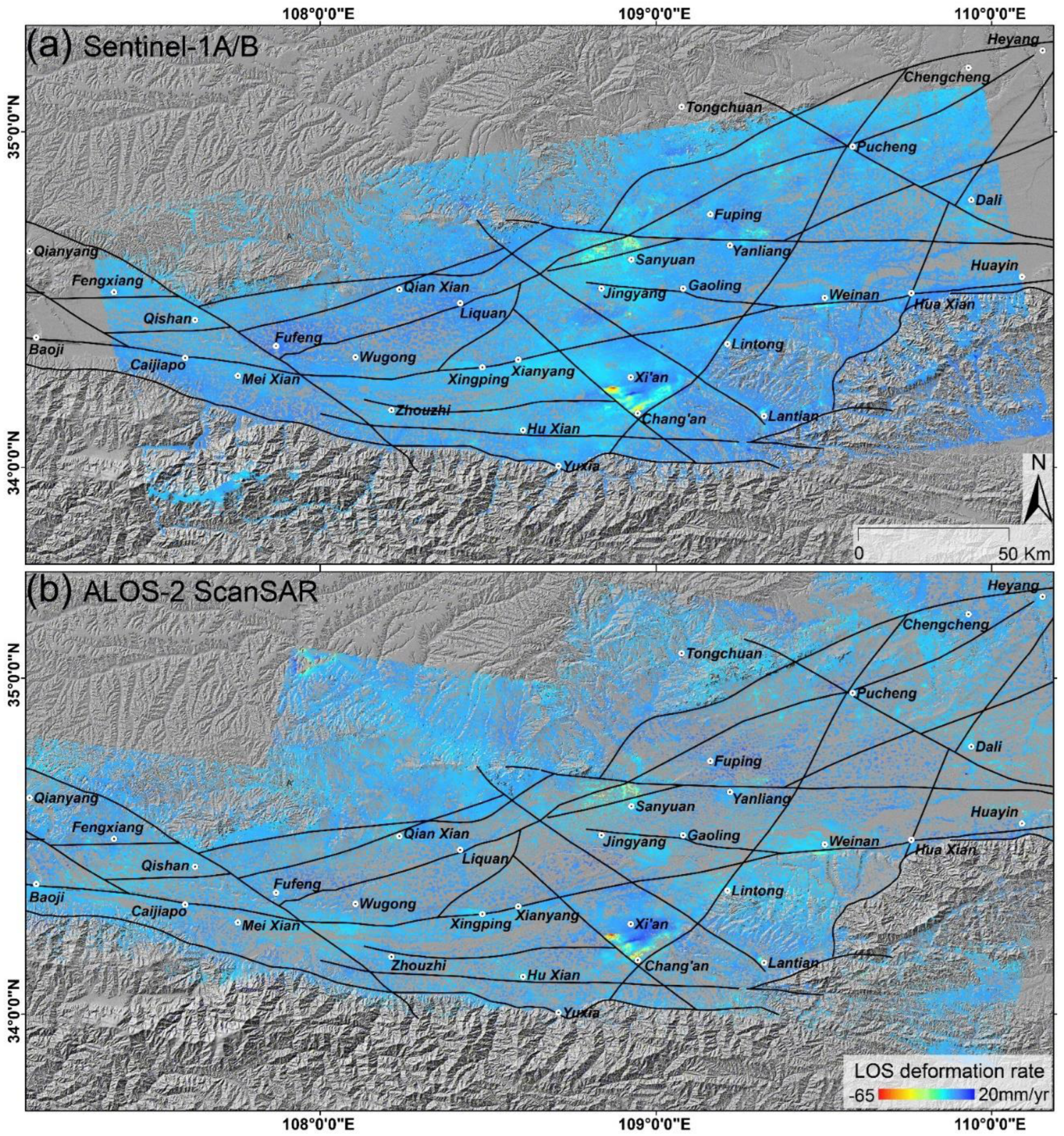
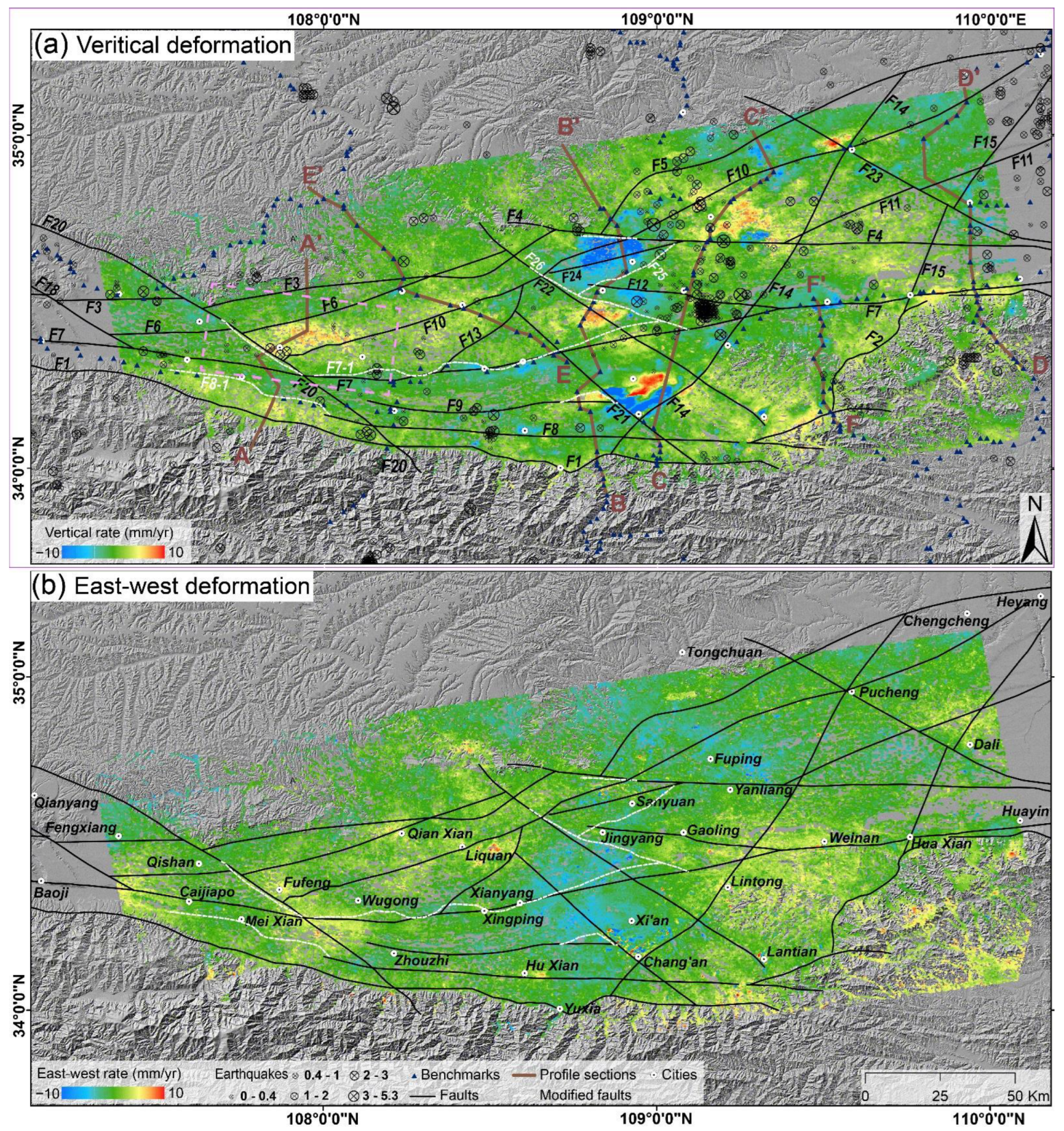
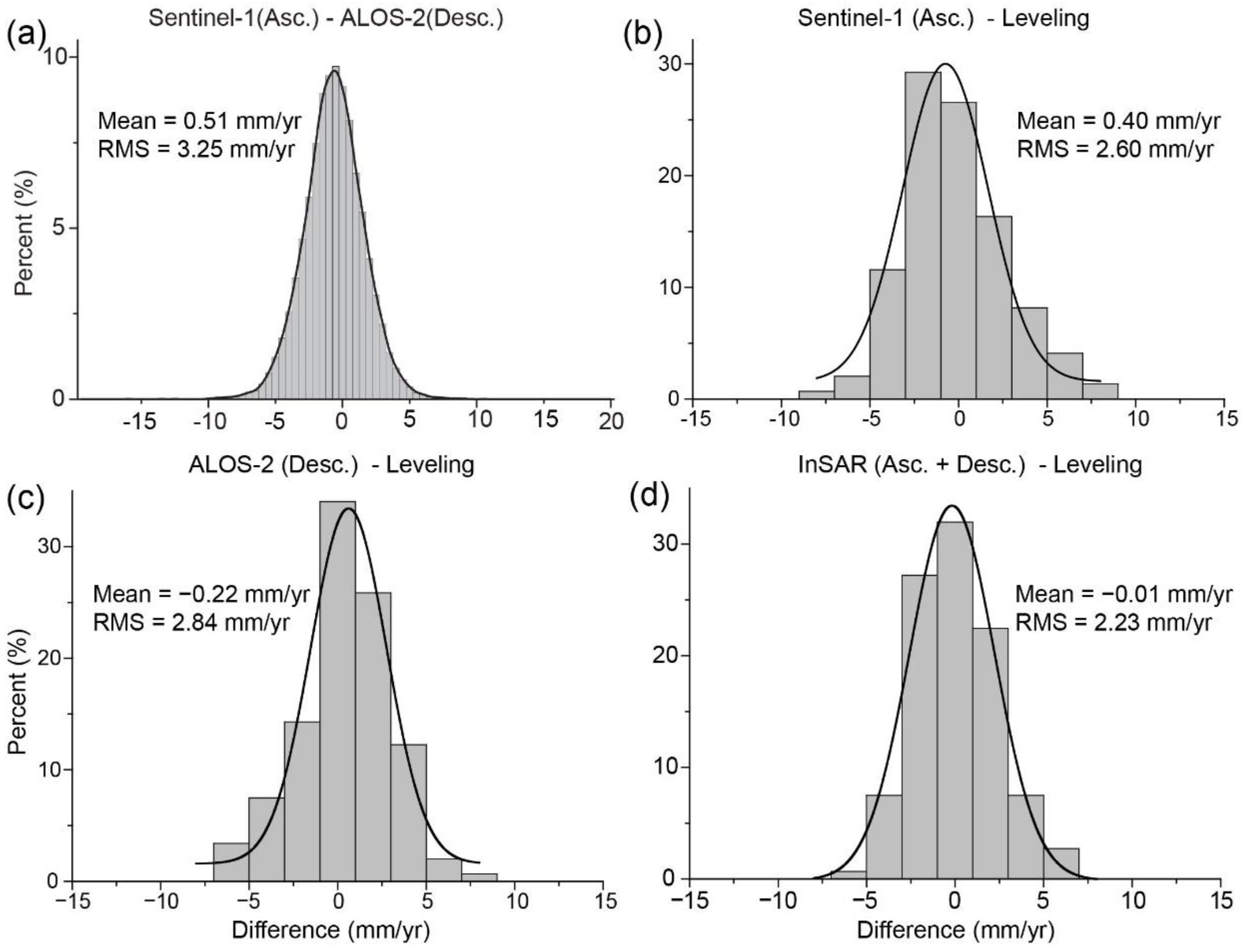
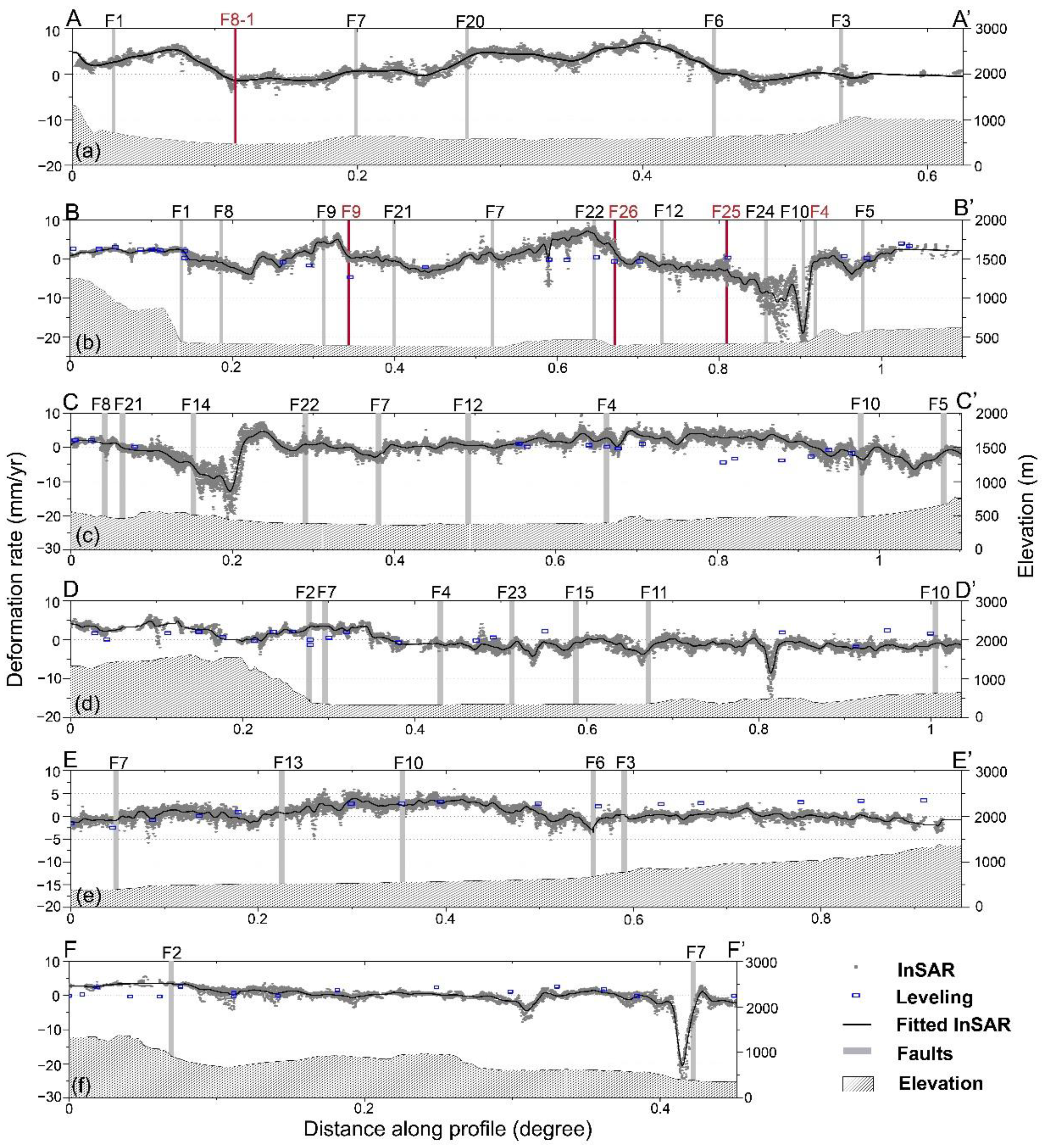
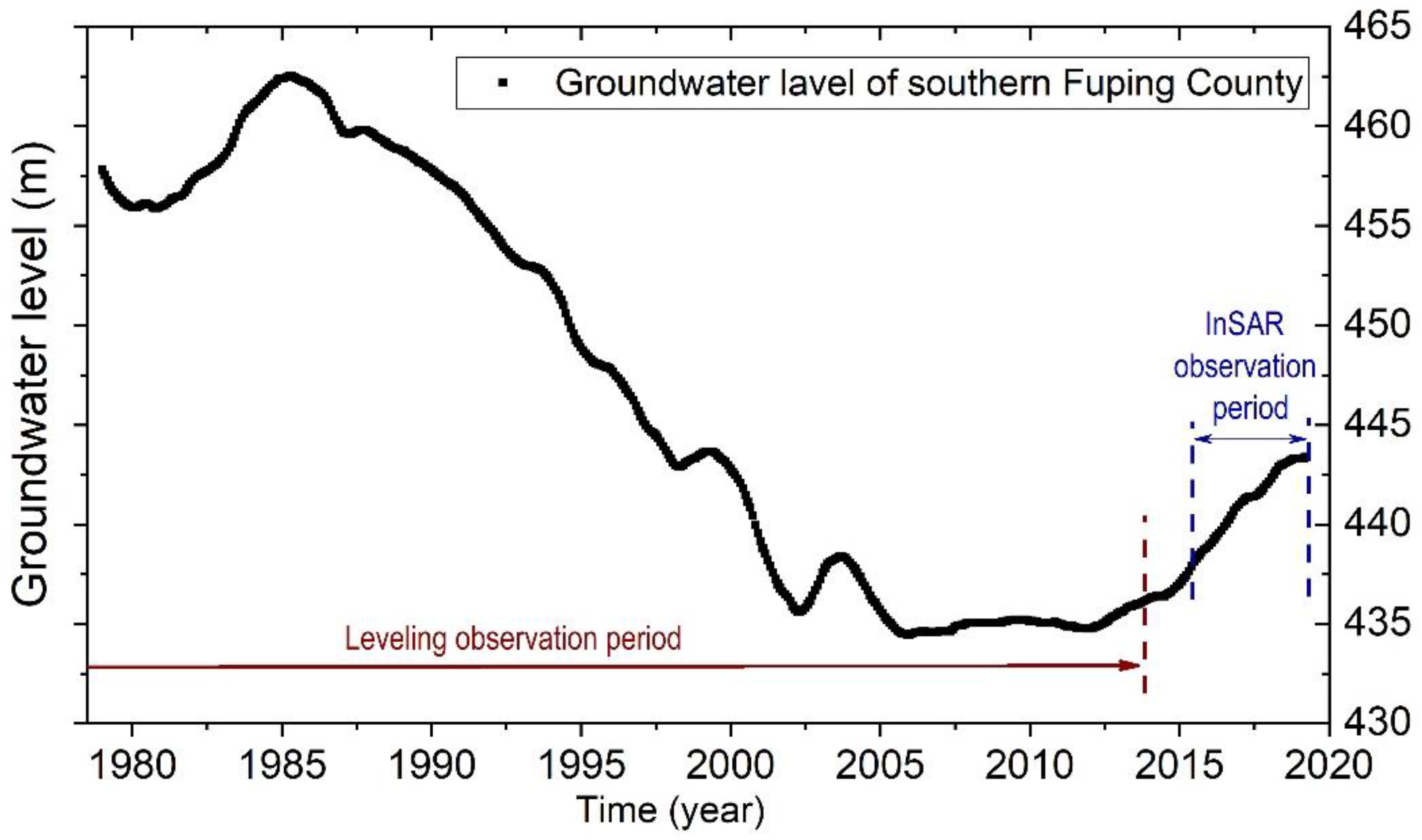
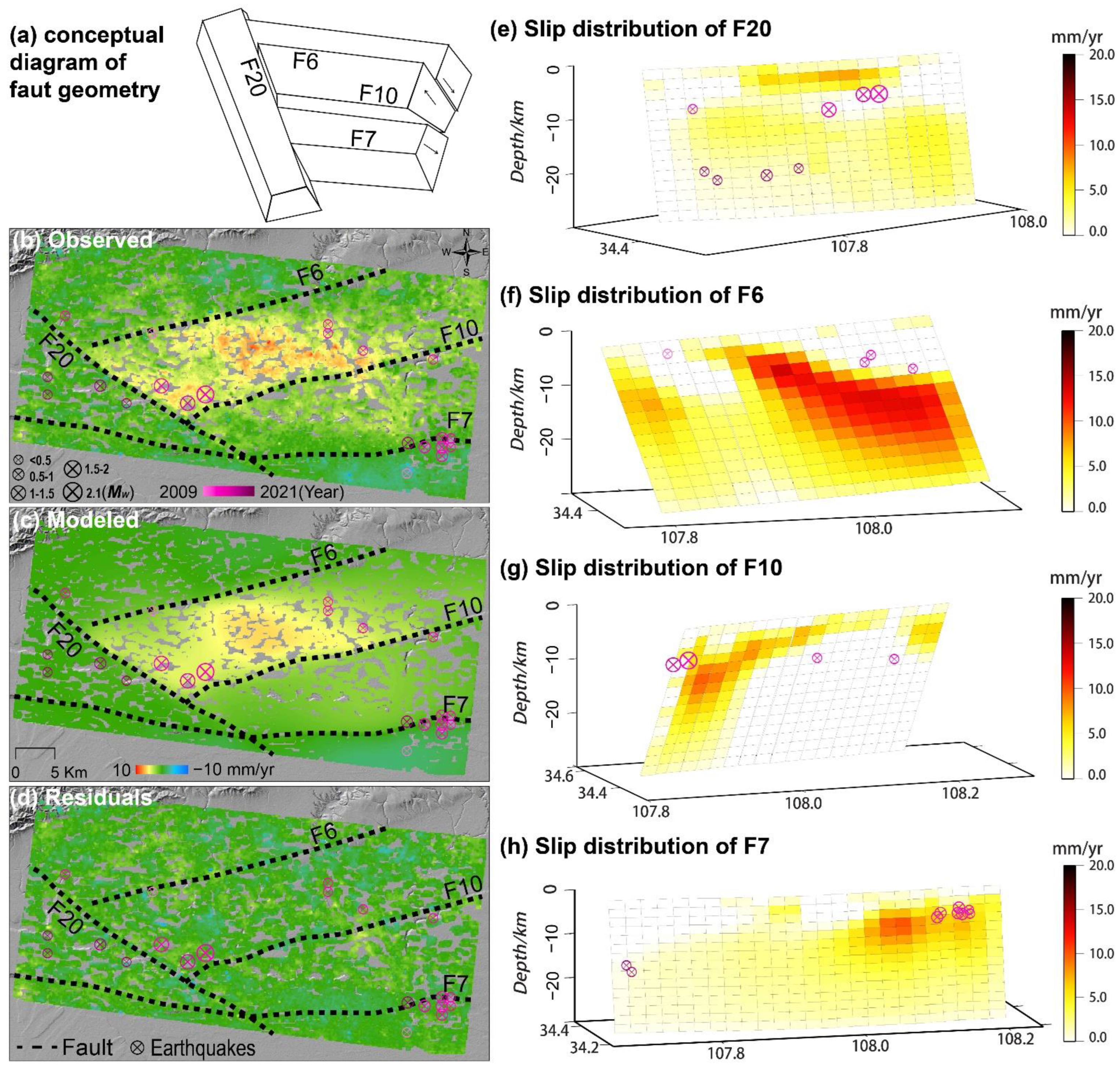
| SAR Satellite | Sentinel-1 | ALOS-2 ScanSAR |
|---|---|---|
| Band | C | L |
| Polarization | VV | HH |
| Wavelength (cm) | 5.6 | 23.6 |
| Path | 84 | 36 |
| Frame | 105–110 | 2900 |
| Heading (°) | −10.1 | −167.3 |
| Range of Incidence angle (°) | 29–46 | 26–49 |
| Number of used scenes | 92 | 6 |
| Date range (yyyymmdd) | 20 June 2015–30 September 2019 | 13 April 2015–19 December 2018 |
| Route | Faults Crossed | Observation Time |
|---|---|---|
| Cuifeng | Qishan–Mazhao Fault | 1980, 1986, 2006, 2014 |
| Xianbao | Weihe Fault | 1980, 1986, 1996, 2014 |
| Lanxi | Weihe Fault | 1973, 1977, 1980, 1985, 1986, 1994, 1996, 1998 |
| Baobao | Qinling Mountain Fault | 1972, 1980, 1996, 2006, 2009 |
| Zhoucheng | Qinling Mountain Fault | 1980, 1996, 2014 |
| Bengguang | Qinling Mountain Fault | 1987, 2006, 2014 |
| Fulan | Huashan Mountain Fault | 1980, 1986, 1996, 2006, 2014 |
| Scheme | Correlation | RMS (mm/y) | ||
|---|---|---|---|---|
| One fault | F20 | Model A-1 | 0.7281 | 1.7 |
| F6 | Model A-2 | 0.8091 | 1.4 | |
| F10 | Model A-3 | 0.6388 | 1.9 | |
| Two faults | F6, F10 | Model B-1 | 0.8713 | 1.2 |
| F6, F20 | Model B-2 | 0.8671 | 1.2 | |
| F10, F20 | Model B-3 | 0.8211 | 1.4 | |
| Three faults | F6, F10, F20 | Model C | 0.8895 | 1.1 |
| Four faults | F6, F20, F10, F7 | Model D | 0.9171 | 1.0 |
| Fault Model | Degrees of Freedom | χ2 (misfit) | F20 | F6 | F6, F20 | F6, F10 |
|---|---|---|---|---|---|---|
| F20 | 240 | 0.687 | ||||
| F6 | 255 | 0.588 | ||||
| Fcalculated | [42.654] | |||||
| Fcritical | 1.669 | |||||
| F10 | 270 | 0.770 | ||||
| Fcalculated | −13.618 | |||||
| Fcritical | 1.462 | |||||
| F6, F20 | 495 | 0.498 | ||||
| Fcalculated | [5.286] | [2.670] | ||||
| Fcritical | 1.156 | 1.161 | ||||
| F6, F10 | 525 | 0.492 | ||||
| Fcalculated | [4.938] | [2.577] | [1.707] | |||
| Fcritical | 1.148 | 1.152 | 1.462 | |||
| F10, F20 | 510 | 0.571 | N/A | |||
| Fcalculated | [2.665] | 0.411 | ||||
| Fcritical | 1.152 | 1.114 | ||||
| F6, F10, F20 | 765 | 0.457 | ||||
| Fcalculated | [3.156] | [1.851] | 1.105 | |||
| Fcritical | 1.113 | 1.114 | 1.153 | |||
| F6, F20, F10, F7 | 1140 | 0.399 | ||||
| Fcalculated | [2.347] | [1.568] | [1.134] | [1.118] | ||
| Fcritical | 1.092 | 1.092 | 1.105 | 1.107 |
Publisher’s Note: MDPI stays neutral with regard to jurisdictional claims in published maps and institutional affiliations. |
© 2022 by the authors. Licensee MDPI, Basel, Switzerland. This article is an open access article distributed under the terms and conditions of the Creative Commons Attribution (CC BY) license (https://creativecommons.org/licenses/by/4.0/).
Share and Cite
Qu, F.; Zhang, Q.; Niu, Y.; Lu, Z.; Wang, S.; Zhao, C.; Zhu, W.; Qu, W.; Yang, C. Mapping the Recent Vertical Crustal Deformation of the Weihe Basin (China) Using Sentinel-1 and ALOS-2 ScanSAR Imagery. Remote Sens. 2022, 14, 3182. https://doi.org/10.3390/rs14133182
Qu F, Zhang Q, Niu Y, Lu Z, Wang S, Zhao C, Zhu W, Qu W, Yang C. Mapping the Recent Vertical Crustal Deformation of the Weihe Basin (China) Using Sentinel-1 and ALOS-2 ScanSAR Imagery. Remote Sensing. 2022; 14(13):3182. https://doi.org/10.3390/rs14133182
Chicago/Turabian StyleQu, Feifei, Qin Zhang, Yufen Niu, Zhong Lu, Shuai Wang, Chaoying Zhao, Wu Zhu, Wei Qu, and Chengsheng Yang. 2022. "Mapping the Recent Vertical Crustal Deformation of the Weihe Basin (China) Using Sentinel-1 and ALOS-2 ScanSAR Imagery" Remote Sensing 14, no. 13: 3182. https://doi.org/10.3390/rs14133182
APA StyleQu, F., Zhang, Q., Niu, Y., Lu, Z., Wang, S., Zhao, C., Zhu, W., Qu, W., & Yang, C. (2022). Mapping the Recent Vertical Crustal Deformation of the Weihe Basin (China) Using Sentinel-1 and ALOS-2 ScanSAR Imagery. Remote Sensing, 14(13), 3182. https://doi.org/10.3390/rs14133182









